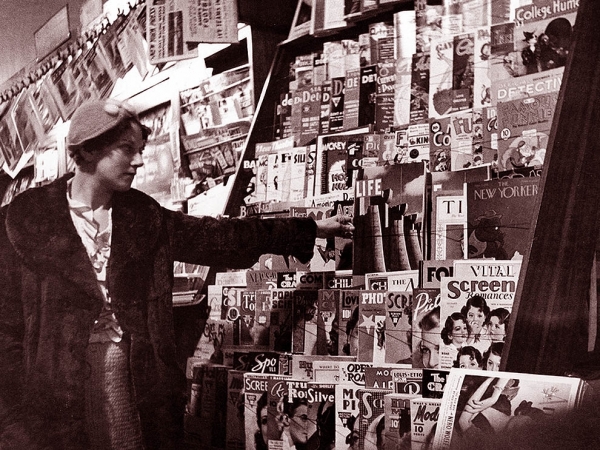Recently Added ArticlesClick here to be notified when articles
are added to your favorite categories 
- from Amazon:
 Kicking God Out of the Schools (Newsweek Magazine & PM Tabloid, 1945)
"A religion-in-the-schools trial, held last week in the Champaign, Illinois Circuit Court, will probably make history. The plaintiff was Mrs. Vashti McCollum, 32, pert, wide-eyed wife of a University of Illinois professor, demanding that the Champaign School Board discontinue a five-year program of religious instruction in school buildings, on the ground that the constitutional separation of church and state is jeopardized."
Click here to read about Darwin in the schools.
Joe Rosenthal on Iwo Jima (Collier's Magazine, 1955)
Associated Press combat photographer Joe Rosenthal (1911 – 2006) wrote the attached article ten years after snapping the world famous image of the four U.S. Marines and one Navy corpsman raising the American flag on Mount Suribachi during the battle of Iwo Jima. In five pages, he explains the remarkable impact that the photo had on the American psyche as well as the popular culture on the American home front, both during the war and afterward. Rosenthal was awarded a Pulitzer Prize for capturing on film one of the greatest events of W.W. II and briefly explains that the three surviving men who participated in the event were thrust into fame for years afterward.
•Read our article about the treason of Ezra Pound.•
Paris: Literary Capital of America (NY Times Book Review, 1923)
This article lists a surprising number of American authors who had all found high levels of productivity in the city of Paris, both during the Great War and afterward:
"In Paris the American author seems to get the right perspective of his native land. Three thousand miles away he finds himself better able to interpret or criticize the land of the free. Permeated by the French atmosphere, he suddenly develops a huge interest in America, and this interest, in turn, expresses itself usually in the form of a novel."
Observations Concerning Comic Strips (Vanity Fair, 1923)
"From a study that covers practically all the comic sequences, I have roughly estimated that sixty percent deal with the unhappiness of married life, fifteen percent with other problems of the home, such as disagreeable children, and in the other fifteen is grouped a miscellany of tragic subjects - mental or social inferiority, misfortune and poverty. This last group contains a few subjects that carry no definite plan from day-to-day but are based on transient jokes such a Prohibition and the income tax."
50,000 Klansmen March in Washington, D.C. (Literary Digest, 1925)
A report on the August, 1925 KKK march in Washington, D.C.:
"The parade itself marshaled 'from 50,000 to 60,000 white-robed men and women' as the correspondent of the The New York Times estimates, and H.L. Mencken tells us in the New York Sun":"The Klan put it all over its enemies. The parade was grander and gaudier, by far than anything the wizards had prophesied. It was longer, it was thicker, it was higher in tone. I stood in front of the treasury for two hours watching the legions pass. They marched in lines of eighteen or twenty, solidly shoulder to shoulder. I retired for refreshment and was gone an hour. When I got back Pennsylvania Avenue was still a mass of white from the Treasury down to the foot of Capitol Hill - a full mile of Klansmen..."
Click here to learn about the origins of the term "Jim Crow".
U.S. Advertising During W.W. II (Yank Magazine, 1944)
"Advertising is the modern procedure for making ideas and suggestions plain and persuasive. The essence of advertising is the distribution of information in understandable and pleasing doses. Pictures, type, arguments illustrated by words or photographs, comedy, eloquence, music - all of these human devices to enlist interest, to hold attention, to win approval, to convince, have to be employed. They have been used in this war successfully and honorably in [a] great cause."
Articles about the importance of fashion models in 1940s advertising can be read here.
''Making the Immigrant Unwelcome'' (Literary Digest, 1921)
To read this 100-year-old article is to understand that the inhumane conditions of today's alien detention centers on the Southwest border are a part of a larger continuum in American history. This article addressed the atrocious conditions and brutality that was the norm on Ellis Island in the Twenties.
"But it is not the stupidity of the literacy test alone that is to be condemned. It is its inhumanity."
''The New Deal Was Not Fascist'' (The Atlantic Monthly, 1933)
"In certain quarters it is asserted that Mr. Roosevelt's 'New Deal' is nothing other than the first stage of an American movement toward Fascism. It is said that, although the United States has not yet adopted the political structure of Italy and Germany, the economic structure of the country is rapidly being molded upon the Fascist pattern."
FDR's D-Day prayer can be read here
The First Wave (Newsweek Magazine, 1944)
"'Down ramp!' shouted the coxswain from the elevated stern."
"Down it came with a clank and splash. Ahead - and it seemed at that moment miles off - stretched the sea wall. At Lieutenant Crisson's insistence we had all daubed our faces with commando black. I charged out with the rest, trying to look fierce and desperate, only to step into a shell hole and submerge myself in the channel. Luckily my gear was too wet and stinking to put on so I was light enough to come up."
This Newsweek journalist was the only allied war correspondent to have witnessed the derring-do of those in the first wave.
Click here to read more about the D-Day reporters.
''I'm No Communist'' (Photoplay Magazine, 1948)
Months after his appearance as a spectator at the House Committee on Un-American Activities, actor Humphrey Bogart wrote this article for the editors of Photoplay Magazine addressing the topic of communist infiltration in the Hollywood film industry:
"In the final analysis, this House Committee probe has had one salutary effect. It has cleared the air by indicating what a minute number of Commies there really are in the film industry. Though headlines may have screamed of the Red menace in the movies, all the wind and the fury actually proved that there's been no Communism injected on American movie screens."
|
Did You Not See Your Search Article
On This Page?
The Subject You Are Seeking Is On This Site,
It Has Simply Been Removed From This Page.
Please Use This Search Engine To Locate It.
|